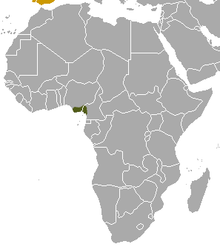Crested servaline genet
| Crested servaline genet | |
|---|---|

| |
| Illustration of a crested servaline genet | |
| Scientific classification | |
| Domain: | Eukaryota |
| Kingdom: | Animalia |
| Phylum: | Chordata |
| Class: | Mammalia |
| Order: | Carnivora |
| Suborder: | Feliformia |
| Family: | Viverridae |
| Genus: | Genetta |
| Species: | G. cristata
|
| Binomial name | |
| Genetta cristata Hayman, 1940
| |

| |
| Crested servaline genet range | |
| Synonyms | |
| |
The crested servaline genet (Genetta cristata), also known as the crested genet, is a
loss of habitat, it is listed as Vulnerable on the IUCN Red List.[1] It was first recorded in the Mamfe Division in Cameroon and initially considered a subspecies of the servaline genet (Genetta servalina).[3] But now it is regarded as a distinct species.[4]
Characteristics

The crested servaline genet is a rather small and slender genet with relatively long legs and a narrow face. Its khaki colored fur is short, soft and dense with dark spots that are densely and evenly distributed. Its long tail is banded with wide black bands and thin whitish bands. Its crest on the back of the neck does not extend onto the back.[5]
Its feet are dark. It has a dark discontinuous mid-dorsal line with relatively long hairs that form a
nuchal crest.[6]
Distribution and habitat
The crested servaline genet occurs in southern
In Nigeria it is associated with
flooded forest. It avoids suburban areas, pineapple plantations, bushlands and oil-palm plantations.[7]
It is restricted to lower elevations from sea level to about 1,000 m (3,300 ft) elevation. Its presence has been predicted in Republic of Congo, but not been confirmed.[8]
Threats
The crested servaline genet is threatened by
loss of habitat. The major areas of its occurrence in the Cross River State Forests is being converted into agriculturally used land; oil is produced in the Niger Delta. It may also be subject to pressure from intensive hunting.[1]
References
- ^ . Retrieved 19 November 2021.
- OCLC 62265494.
- ^ Hayman, R. W. (1940). Genetta servalina cristata. Page 686 in: Sanderson, I. T. (ed). The Mammals of the North Gameroons Forest Area. Being the Results of the Percy Sladen Expedition to the Mamfe Division of the British Cameroons. The Transactions of the Zoological Society of London 24 (7): 623–726.
- ^ Gaubert, P., Taylor, P. J., & Veron, G. (2005). Integrative taxonomy and phylogenetic systematics of the genets (Carnivora, Viverridae, Genetta): a new classification of the most speciose carnivoran genus in Africa. In: Huber, B. A., Sinclair, B. J., Lampe, K.-H. (eds.) African Biodiversity: Molecules, Organisms, Ecosystems. Proceedings of the 5th International Symposium of Tropical Biology, Museum König, Bonn. Springer. Pp. 371–383.
- ISBN 0-12-408355-2.
- ^ Gaubert, P., Taylor, P. J., Veron, G. (2005). Integrative taxonomy and phylogenetic systematics of the genets (Carnivora, Viverridae, Genetta): a new classification of the most speciose carnivoran genus in Africa. In: BA Huber, BJ Sinclair, K-H Lampe (eds.) African Biodiversity: Molecules, Organisms, Ecosystems. Proceedings 5th International Symposium Tropical Biology, Museum König, Bonn. Springer Verlag.
- ^ Angelici, F.M. and Luiselli, L. (2005). Habitat associations and dietary relationships between two genets, Genetta maculata and Genetta cristata. Revue d'Écologie (La Terre et la Vie) 60: 341–354.
- ^ Gaubert, P., Papes, M. and Peterson, A.T. (2006). Natural history collections and the conservation of poorly known taxa: Ecological niche modeling in central African rainforest genets (Genetta spp.). Biological Conservation 130: 106–117.

